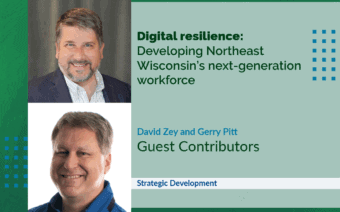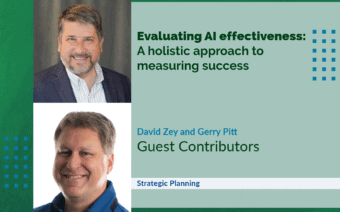
November 4, 2024
Artificial intelligence (AI) has become one of the most talked-about topics in business today.
The promise of automation, efficiency and enhanced decision-making has created a buzz that many leaders are eager to explore.
Yet, amid the hype, it’s important to recognize that AI adoption is, at its core, process improvement.
It’s not about adopting flashy new technologies just for the sake of it, but about using these tools to make everyday work better and more efficient.
But where should you start, and how can you guide your team through the change?
What is process improvement?
At its heart, process improvement is about making changes to how you do things to achieve better results.
It’s the methodical approach to refining workflows, reducing inefficiencies and enabling teams to focus on what matters most.
Though this may sound like a daunting task, process improvement often starts with something simple: identifying the things that frustrate you.
Imagine a task that makes your stomach turn every time it comes up – perhaps a cumbersome reporting process or a repetitive data entry job.
Process improvement is about finding ways to make those tasks easier or more efficient, delivering the same or better outcomes without the headache.
This might sound funny, but it’s true – we often feel when a process is inefficient long before we can analyze why.
In many ways, the things we complain about daily are indicators that point to where change is needed.
For businesses, adopting process improvement means unburdening your most valuable resources – your people – to focus on driving growth.
It’s about finding ways to boost productivity without burning out your team, and that’s where AI can be a game-changer.
It’s all about AI these days – but it’s really not
After a couple years of media buzz, many business leaders might be wondering, “What does AI even mean for us?”
It’s easy to see AI as a confusing, distant concept.
But at its core, AI is just a tool – one that helps automate, predict and optimize processes that are already part of your business.
Unlike software you can buy off a shelf, AI is not something you can plug into a USB port and instantly transform your operations.
Instead, AI is about continuously improving your business, using the people, resources and technologies you already have.
It’s not magic, and it won’t solve all your problems overnight.
But for businesses that have already embraced process improvement, AI is a natural next step toward achieving new levels of efficiency and ROI.
A roadmap for AI adoption through process improvement
If you’re considering bringing AI into your business, where do you start?
Here’s a step-by-step roadmap to help guide you through the process:
Step 1. Start with an AI Assistant
One of the easiest ways to dip your toes into AI is by implementing an AI Assistant – a controlled chatbot that can help manage routine inquiries, automate basic tasks and serve as a hub for workflow automation.
This approach allows your business to experiment with AI in a safe environment, ensuring that IT security risks are managed while you build a foundation for AI-driven improvements.
Step 2. Identify high-impact use cases
Next, identify specific tasks in your business that could benefit from AI’s capabilities.
Focus on areas where AI can streamline operations or enhance productivity.
For example:
- Automating configure, price and quote (CPQ) processes based on client specifications
- Using past experiences and industry knowledge to configure new job setups
- Improving machine maintenance schedules by predicting failures using IoT data
These use cases should align with your business goals and address pain points that you’re eager to resolve.
By focusing on high-impact opportunities, you’ll ensure that your AI investment delivers measurable returns.
Step 3. Prepare your data
Data is the lifeblood of any AI project, and its quality will directly impact your outcomes.
Start by grading your internal data for accuracy and completeness and promote high-quality data to train your AI Assistant.
Gather input data and expected results for each use case – remember, the cleaner your data, the better your results.
Preparing your data may sound tedious, but it’s a crucial step that sets the stage for success.
Think of it as laying a strong foundation before building a new structure – without it, even the most sophisticated AI solutions will struggle to deliver value.
Step 4. Run PoV labs
Once you’ve identified a use case and prepared your data, it’s time to test your ideas through Proof of Value (PoV) labs.
A PoV is essentially an experiment where you apply AI to a specific problem to determine whether it delivers the expected value.
This step requires a combination of business expertise and technical know-how – most likely, you’ll need to partner with a cloud provider like Microsoft Azure and work with technical experts.
A typical PoV might require 100-120 hours of effort to develop and refine a solution, depending on how well-defined your use case is and how clean your data is.
From a budget perspective, businesses should plan for around $15,000-$20,000 for a custom AI solution.
This investment needs to be weighed against the potential savings, long-term cost reductions and even intangible benefits like improved customer satisfaction.
Step 5. Deploy, use and maintain your AI solutions
Once you’ve validated an AI solution through a PoV, the next step is deployment.
This involves integrating the new process into your operations and training your team on how to use it.
AI Assistants can be particularly valuable here, acting as a central source of information and helping onboard team members with context, documentation and use cases.
But deployment isn’t the end of the journey.
AI models and processes need to be monitored and refined over time.
Employees should be encouraged to provide feedback, flagging when something doesn’t work as expected and suggesting improvements.
This feedback loop ensures that your AI solutions continue to deliver value as your business evolves.
Generational knowledge: A key to success
Incorporating AI into business processes is not just a technological challenge – it’s a cultural one as well.
Different generations bring different perspectives to the table, and businesses that can bridge these differences are more likely to succeed.
Leaders can tap into the tech-savvy skills of newer-generation employees, allowing them to act as champions for change and mentors to their peers.
Younger workers, who often have a more intuitive understanding of digital tools, can help demystify AI for others.
They can be instrumental in explaining the benefits, guiding hands-on training sessions and ensuring that AI processes are properly integrated into daily routines.
At the same time, more-experienced employees bring a deep understanding of the business that is crucial for identifying valuable use cases and providing feedback on AI solutions.
By fostering a culture of collaboration and mutual learning, businesses can create a smoother transition to AI adoption and ensure all team members feel supported and valued throughout the process.
Conclusion
Adopting AI is a process of continuous improvement.
It requires planning, patience and a willingness to learn from both successes and setbacks.
While the journey may seem complex, the potential benefits – greater efficiency, reduced costs, and new opportunities for growth – make it well worth the effort.
As you explore AI for your business, remember to start small, iterate on your successes and listen to your team’s feedback.
Find the right partners to support you, whether that means engaging external experts or leveraging the insights of your own employees.
In a world where change is constant, AI can be your ally in building a more adaptable, efficient business.
And with the right approach, you’ll be well-positioned to thrive in this new era of technological innovation.
 Economic snapshot: Amid U.S. uncertainty, optimism in NE Wisconsin
Economic snapshot: Amid U.S. uncertainty, optimism in NE Wisconsin CapVest, LLC settles into its new offices in Altoona
CapVest, LLC settles into its new offices in Altoona








